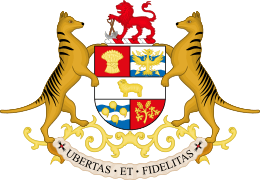Tasmanian House of Assembly
| House of Assembly | |
|---|---|
 | |
| Type | |
| Type | |
| History | |
| Founded | 1856 |
| Leadership | |
Chair of Committees | |
| Structure | |
| Seats | 25 |
 | |
Political groups |
Government Liberal (15) Opposition Labor (7) Crossbench Greens (3) |
| Elections | |
Last general election | 15 March 2014 |
Next general election | by 2018 |
| Meeting place | |
 | |
|
House of Assembly Chamber, Parliament House, Hobart, Tasmania, Australia | |
| Website | |
| House of Assembly | |
The House of Assembly, or Lower House, is one of the two chambers of the Parliament of Tasmania in Australia. The other is the Legislative Council or Upper House. It sits in Parliament House in the state capital, Hobart.
The Assembly has 25 members, with five members coming from each of five electorates with identical names and boundaries as the single-member districts that return Tasmanian members to the Parliament of Australia. Each electorate is intended to represent approximately the same population. Voting for the state parliament is by a form of proportional representation using the single-transferable vote (STV), known as the Hare-Clark system. By having multiple members for each electorate, the voting intentions of the electors are correspondingly represented in the parliament. The system also provides opportunities for individual members to be selected more on their personal attributes, rather than merely as the sole nominee of their political party.
Most legislation is initiated in the House of Assembly. The party or coalition with a majority of the seats in the lower house is invited by the Governor to form a government. The leader of that party subsequently becomes the Premier of Tasmania, and his/her senior colleagues become ministers responsible for various portfolios. As Australian politicians traditionally vote along party lines, most legislation introduced by the governing party will be passed by the House of Assembly.
History
| Year | Members |
|---|---|
| 1856 | 30 |
| 1870 | 32 |
| 1885 | 36 |
| 1893 | 37 |
| 1900 | 35 |
| 1906 | 30 |
| 1959 | 35 |
| 1998 | 25 |
The House of Assembly was first established in 1856, under legislation passed by the British Parliament creating the independent self-governing Colony of Tasmania. The Legislative Council had already existed since 1852. The first elections for the House of Assembly were held in October 1856. The House first met on 2 December 1856 in the area that is now the parliamentary members lounge. The first House had members elected to represent 24 electorates. Hobart had five members, Launceston had three members, and the 22 other electorates each had one member.
In 1906 the old electoral system was abolished. Instead, the state was divided into five equally represented multi-member electorates corresponding to the state's five federal electorates. Each electorate would return six members using the Hare-Clark proportional representation system.
In 1959 the number of members per electorate was increased to seven. In 1998 it was reduced to five, resulting in the current 25-member parliament. The reduction has been criticised by the Greens, as an attempt to reduce their influence. However, since the 2002 election the Green vote has increased and they currently hold three seats. In 2010, the leaders of the three main parties—Labor, the Liberals and the Greens—moved to increase the number of seats in the House back to 35 for the next state election. The three leaders signed an agreement on 2 September to submit the proposal for public consideration before taking a set of resolutions to their respective party rooms.[1] The proposal, however, was dropped in February 2011 when the Liberal Party withdrew its support for the plan, citing budget circumstances.[2]
Unlike most state parliaments in Australia, by-elections are very rare in the House of Assembly. Since 1917, casual vacancies have usually been filled by a simple recount of votes.[3] One of the few by-elections in recent memory occurred in 1980, when the Supreme Court ordered a new election in Denison because three Labor members had exceeded spending limits.[4]
Since 1998, the House of Assembly has had an election threshold of 16.7 percent. After all candidates who meet the threshold are elected, their surplus votes are redistributed as preferences. At the same time, the lowest-polling candidates are excluded, and their votes are distributed as preferences. This all but assures that at least one seat will go to one of an electorate's minority parties. Under current practices, winning 15 seats—only two more than necessary for a majority—is considered a landslide victory.[5]
Electorates
A map from the Tasmanian Electoral Commission showing the electoral boundaries is available here.
Current distribution of seats
| Party | Seats held | Percentage of Assembly | Current House of Assembly | ||||||||||||||
|---|---|---|---|---|---|---|---|---|---|---|---|---|---|---|---|---|---|
| Liberal Party of Australia | 15 | 60% | |||||||||||||||
| Australian Labor Party | 7 | 28% | |||||||||||||||
| Tasmanian Greens | 3 | 12% | |||||||||||||||
- 13 votes as a majority are required to pass legislation.
| Electorate | Seats held | ||||
|---|---|---|---|---|---|
| Bass | |||||
| Braddon | |||||
| Denison | |||||
| Franklin | |||||
| Lyons | |||||
See also
- Parliaments of the Australian states and territories
- Members of the Tasmanian House of Assembly
- List of Tasmanian House of Assembly casual vacancies
References
- ↑ Tassie set to get extra politicians, news.com.au, 2 September 2010.
- ↑ Caruana, Patrick: Deal to increase Tas parliament scuttled, The Sydney Morning Herald, 17 February 2011.
- ↑ House of Assembly Elections, Tasmanian Parliamentary Library
- ↑ Report on Parliamentary Elections 1978 to 1980, Parliament of Tasmania, 1980.
- ↑ Green, Antony. 2014 Tasmanian election preview. ABC News, 2014-01-17.